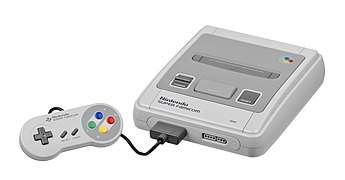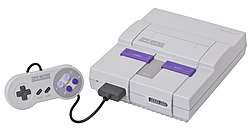Super FX
The Super FX is a coprocessor on the Graphics Support Unit (GSU) added to select Super Nintendo Entertainment System (SNES) video game cartridges, primarily to facilitate advanced 2D and 3D graphics. The Super FX chip was designed by Argonaut Games, who also co-developed the 3D space rail shooter video game Star Fox with Nintendo to demonstrate the additional polygon rendering capabilities that the chip had introduced to the SNES.[1]
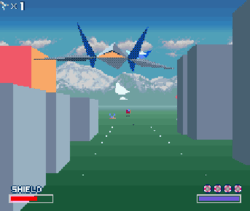
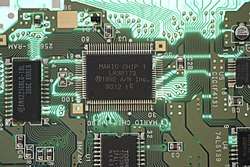
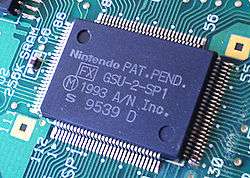
History
The Super FX chip design team included engineers Ben Cheese, Rob Macaulay, and James Hakewill.[2] While in development, the Super FX chip was codenamed "Super Mario FX"[3] and "MARIO". "MARIO", a backronym for "Mathematical, Argonaut, Rotation, & Input/Output", is printed on the face of the final production chip.[4]
Because of higher manufacturing costs and increased development time, few Super FX based games were made compared to the rest of the SNES library. Due to these increased costs, Super FX games often retailed at a higher MSRP compared to other SNES games.[5]
According to Argonaut Games founder Jez San, Argonaut had initially intended to develop the Super FX chip for the Nintendo Entertainment System. The team programmed a NES version of the first-person combat flight simulator Starglider, which Argonaut had developed for PC systems a few years earlier, and showed it to Nintendo in 1990. The prototype impressed the company, but they suggested that they develop games for the then-unreleased Super Famicom due to the NES's hardware which was becoming outdated in light of newer systems such as the Sega Genesis/Mega Drive and the TurboGrafx-16/PC Engine. Shortly after the 1990 Consumer Electronics Show held in Chicago, Illinois, Argonaut ported the NES version of Starglider to the Super Famicom, a process which took roughly one week according to San.[6]
Function
The Super FX chip is used to render 3D polygons and to assist the SNES in rendering advanced 2D effects. This custom-made RISC processor is typically programmed to act like a graphics accelerator chip that draws polygons to a frame buffer in the RAM that sits adjacent to it. The data in this frame buffer is periodically transferred to the main video memory inside of the console using DMA in order to show up on the television display.
The first version of the chip, commonly referred to as simply "Super FX", is clocked with a 21.4 MHz signal, but an internal clock speed divider halves it to 10.7 MHz.[7] Later on, the design was revised to become the Super FX GSU (Graphics Support Unit); this, unlike the first Super FX chip revision, is able to reach 21 MHz.
All versions of the Super FX chip are functionally compatible in terms of their instruction set. The differences arise in how they are packaged, their pinout, and their internal clock speed. As a result of changing the package when creating the GSU-2, more external pins were available and assigned for addressing. As a result, a larger amount of external ROM or RAM can be accessed.
Usage
Star Fox uses the chip for the rendering of hundreds of simultaneous 3D polygons. It uses scaled 2D bitmaps for lasers, asteroids, and other obstacles, but other objects such as ships are rendered with 3D polygons. Super Mario World 2: Yoshi's Island uses the chip for 2D graphics effects like sprite scaling and stretching.
Game cartridges that contain a Super FX chip have additional contacts at the bottom of the cartridge that connect to the extra slots in the cartridge port that are not otherwise typically used. Therefore, Super FX games cannot be plugged into cartridge adapters which predate the release of Super FX games. This includes cheat devices, such as the Game Genie.
List of games
Super FX games
- Dirt Racer[8]
- Dirt Trax FX[9]
- Star Fox (US/Japan) / Starwing (Europe)[10]
- Stunt Race FX (US/Europe) / Wild Trax (Japan)[11]
- Vortex[12]
Super FX 2 games
- Doom[13]
- Super Mario World 2: Yoshi's Island[14]
- Winter Gold[15]
Unreleased games
- Comanche[16]
- Powerslide (developed at the same time as Dirt Racer)[17]
- FX Fighter[16]
- Transformers Generation 2 (abandoned during development)[18]
- Star Fox 2 (eventually released with the Super NES Classic Edition in 2017)[19]
See also
- List of Super NES enhancement chips
- ARC (processor)
- Synopsys § ARC International - continued development Super FX technology
References
- "Of argonauts, vectors, and flying foxes: The rise of 3D on Nintendo consoles". BlameTheControlPad.com. Archived from the original on June 13, 2008. Retrieved January 4, 2015.
- Retrobates (April 3, 2014). "Blood". Retro Gamer.
We did most of the technology back in England with a relatively large engineering/tech team, which comprised of Carl Graham and Pete Warnes on the software-based 3D technology and Ben Cheese, Rob Macaulay and James Hakewill working on the hardware side of things
- "Dylan Cuthbert". Twitter. Archived from the original on May 25, 2014. Retrieved May 25, 2014.
SNES Central: @dylancuthbert I'm researching unreleased SNES games, was a game called "Super Mario FX" ever in development?
Dylan Cuthbert: @snescentral no, that was the internal code name for the FX chip" - McFerran, Damien (July 4, 2013). "Born slippy: the making of Star Fox". Eurogamer. Gamer Network. Retrieved July 4, 2013.
- "Cart Queries" (PDF). GamePro (59). IDG. June 1994. p. 12.
- Brookes, Jason; Bielby, Matt (May 1993). "Superplay interview: Jez San, Argonaut". Super Play. No. 7. United Kingdom: Future Publishing. p. 26.
- Electric Brain #34. May 1993.
- "Dirt Racer". SNES Central. Retrieved July 20, 2014.
- "Dirt Trax FX". SNES Central. Retrieved July 20, 2014.
- Strauss, Bob (April 2, 1993). "Star Fox". EW.com. Retrieved January 1, 2019.
- "Stunt Race FX". SNES Central. Retrieved July 20, 2014.
- "Vortex". SNES Central. Retrieved July 20, 2014.
- "Doom". SNES Central. Retrieved July 20, 2014.
- Harris, Craig (May 24, 2002). "E3 2002: Hands-on Impressions: Yoshi's Island". IGN. Ziff Davis. Archived from the original on August 20, 2016. Retrieved January 1, 2019.
- F.J. McCloud. "A Super FX FAQ". anthrofox.org. Retrieved 13 September 2019.
- MegaSilverX1 (July 4, 2013). "Super FX Series: Cancelled Super FX Games". ScrewAttack.com. Archived from the original on August 30, 2013.
- Lee (October 28, 2009). "Powerslide FX [SNES / 3DO - Unreleased] - Unseen64". Unseen64.
- "The Making of: Vortex". Retro Gamer (147): 38–41. October 2015.
- Sao, Akinori. "Developer Interview: Star Fox & Star Fox 2 - Super Nintendo Entertainment System: Super NES Classic Edition - Official Site". Nintendo of America. Retrieved January 18, 2018.
External links
| Wikibooks has a book on the topic of: Super NES Programming/Super FX tutorial |
- "Nintendo Land Tech Page". Archived from the original on April 11, 2009. Retrieved May 9, 2019.
